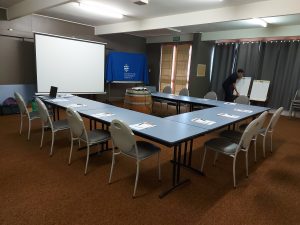Chapter 5: Implementing place-based planning: Staffing, logistics and costs
Resources required to implement place-based health planning will depend on various factors. In the illustrative project described in this book, an external party (the university) initiated the planning work. Some of the costs associated with conducting the work included:
- employment of project staff
- employment of a Local Connector (and provision of support and networking opportunities)
- travel costs for the university team to the community – flights, car hire, accommodation, meals and subsistence – this will vary considerably depending on the location of the community
- venues to hold workshops and meetings – community halls and clubs are generally more cost-effective, than restaurants/cafes with function rooms
- set up the meeting space with tables and chairs where possible, to allow participants to sit comfortably and face each other to encourage interaction and discussion (Figure 4.5.1)
- catering and refreshments for workshops – consider dietary requirements
- remuneration and reimbursement for participants that reflects Health Consumers Queensland Guidelines
- printing of posters, flyers for communications and promotion
- newsletter publishing costs.

Figure 4.5.1 Workshop set up.
There may be opportunities to partner with local organisations who may contribute to costs or support activities in-kind.
If the planning work is being driven by a local organisation or key stakeholder, costs may be able to be covered partially or entirely by that organisation.
Implementing actions
The aim of the planning work was to identify actions that were cost-neutral, that is, could be implemented at no additional cost. While this was achievable for some initiatives, certain expenses, such as the time commitment of the local connector, were unavoidable. Additionally, minor costs, primarily related to printing resources, were covered by the university.
However, the actions may have also led to cost savings. Raising awareness and encouraging the use of telehealth may have reduced expenses for both individuals and health services, as some people no longer needed to travel to the main referral centre for care. Additionally, filling a vacant part-time maternity and child health position — already on the nursing establishment — enabled local access to these services, further minimising the need for travel. These outcomes will be reported in a separate publication.

Listen to our Local Connectors talk about benefits of their roles:

